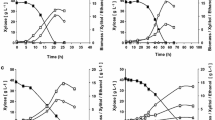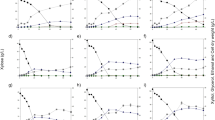Abstract
The determination of optimum values of volumetric oxygen transfer coefficient (kLa) for Spathaspora passalidarum is an important aspect for the optimization of ethanol production from pentoses since oxygen plays a key role on yeast metabolism. By studying the fermentation of a xylose and glucose mixture, the highest ethanol volumetric productivity was achieved at a kLa of 45 h−1 (1.12 gethanol L−1 h−1), reducing the fermentation time to half when compared to other oxygen-limiting conditions that were considered optimum for other native strains, besides increasing xylose consumption rates. The high cell density fermentation showed to be a good strategy to be applied in industrial processes with S. passalidarum, enabling the complete exhaustion of a high initial substrate concentration (90 g L−1) in less than 24 h, with a final ethanol titer of 28.61 (± 0.42) g L−1. By performing a detailed investigation on oxidation–reduction potential (ORP), it was possible to conclude that the highest ethanol formation rates were registered at oxireduction potential values around − 100 mV, becoming an important parameter to be controlled when oxygen-limiting conditions are applied in industrial fermentations. The oxygen availability also affected the activity of enzyme XR and its preference for NADH or NADPH, directly affecting the activity of enzyme XDH and the redox imbalance on the xylose pathway. In addition, respirometric parameters were determined for the yeast S. passalidarum under an aerobic growth condition.




Similar content being viewed by others
References
Veras HCT, Parachin NS, Almeida JRM (2017) Comparative assessment of fermentative capacity of different xylose-consuming yeasts. Microb Cell Factor 16(1):153
Nakanishi SC, Soares LB, Biazi LE, Nascimento VM, Ienczak JL, Rocha GJM (2017) Fermentation strategy for second generation ethanol production from sugarcane bagasse hydrolyzate by Spathaspora passalidarum and Scheffersomyces stipitis. Biotechnol Bioeng 114:2211–2221
Silva JPA, Mussato SI, Roberto IC, Teixeira JA (2012) Fermentation medium and oxygen transfer conditions that maximize the xylose conversion to ethanol by Pichia stipitis. Renew Energy 37:259–265
Santos SC, Dionísio SR, De Andrade ALD, Roque LR, Da Costa AC, Ienczak JL (2015) Fermentation of xylose and glucose mixture in intensified reactors by Scheffersomyces stipitis to produce ethanol. Int J Biol Vet Agric Eng 9(5):482–487
Du Preez JC (1994) Process parameters and environmental factors affecting d-Xylose fermentation by yeasts. Enzyme Microb Technol 16:944–956
Liu CG, Xue C, Lin YH, Bai FW (2013) Redox potential control and applications in microaerobic and anaerobic fermentations. Biotechnol Adv 31:257–265
Liu CG, Qin JC, Lin YH (2017) Fermentation and redox potential, fermentation processes, Dr. Angela Jozala, InTech. DOI: 10.5772/64640. Available from: https://www.intechopen.com/books/fermentation-processes/fermentation-and-redox-potential
Hou X (2012) Anaerobic xylose fermentation by Spathaspora passalidarum. Appl Microbiol Biotechnol 94(1):205–214
Long TM, Su YK, Headman J, Higbee A, Willis LB, Jeffries TW (2012) Cofermentation of glucose, xylose, and cellobiose by the beetle-associated yeast Spathaspora passalidarum. Appl Env Microbiol 78:5492–5500
Bonan CIDG, Biazi LE, Santos SC, Soares LB, Dionísio SR, Hoffmam ZB, Costa AC, Ienczak JL (2019) Online monitoring of the redox potential in microaerobic and anaerobic Scheffersomyces stipitis fermentations. Biotechnol Lett 41:753–761
Su YK, Willis LB, Jeffries TW (2015) Effects of aeration on growth, ethanol and polyol accumulation by Spathaspora passalidarum NRRL Y-27907 e Scheffersomyces stipitis NRRL Y-7124. Biotechnol Bioeng 112(3):457–469
Silva DDV, Dussán KJ, Hernández V, da Silva SS, Cardona CA, Felipe MGA (2016) Effect of volumetric oxygen transfer coefficient (kLa) on ethanol production performance by Scheffersomyces stipitis on hemicellulosic sugarcane bagasse hydrolysate. Biochem Eng J 112:249–257
Nigan JN (2001) Ethanol production from wheat straw hemicellulose hydrolysate by Pichia stipites. J Biotechnol 87:17–27
Hanly TJ, Henson MA (2013) Dynamic metabolic modeling of a microaerobic yeast co-culture: predicting and optimizing ethanol production from glucose/xylose mixtures. Biotechnol Biofuels 6:1–16
Santos SC, Sousa AS, Dionísio SR, Tramontina R, Ruller R, Squina FM, Rossell CEV, Da Costa AC, Ienczak JL (2016) Bioethanol production by recycled Scheffersomyces stipitis in sequencial batch fermentations with high cell density using xylose and glucose mixture. Bioresour Technol 219:319–329
Agbogbo FK, Coward-Kelly G, Torry-Smith M, Wenger K, Jeffries TW (2007) The effect of initial cell concentration on xylose fermentation by pichia stipitis. In: Mielenz JR, Klasson KT, Adney WS, McMillan JD (eds) Applied biochemistry and biotecnology. ABAB symposium. Humana Press
Amorim HV, Lopes ML, de Castro Oliveira JV, Buckeridge MS, Goldman GH (2011) Scientific challenges of bioethanol production in Brazil. Appl Microbiol Biotechnol 91:1267–1275
Basso LC, Basso TO, Rocha SN (2011) Ethanol production in Brazil: the industrial process and its impact on yeast fermentation. In: Marco Aurélio dos Santos Bernardes (Ed.). (Org.). Biofuel production-recent developments and prospects, vol 1, 1st edn. InTech, pp 85–100
Humphrey AE, Taguchi H (1966) Dynamic measurement of the volumetric oxygen transfer coefficient in fermentation systems. J Ferment Technol 44:881–889
Ienczak JL, Schmidt M, Quines LK, Zanfonato K, Pradella JGC, Schmidell W, de Aragão GMF (2016) Poly(3-Hydroxybutyrate) production in repeated fed-batch with cell recycle using a medium with low carbon source concentration. Appl Biochem Biotechnol 178:408–417
Käppeli O, Fiechter A (1981) A convenient method for the determination of oxygen solubility in different solutions. Biotechnol Bioeng 23:1969–1977
Agbogbo FK, Coward-Kelly G (2008) Cellulosic ethanol production using the naturally occuring xylose-fermenting yeast, Pichia stipitis. Biotechnol Lett 30:1515–1524
Rech FR, Fontana RC, Rosa CA et al (2019) Fermentation of hexoses and pentoses from sugarcane bagasse hydrolysates into ethanol by Spathaspora hagerdaliae. Bioprocess Biosyst Eng 42:83–92
Taniguchi M, Tohma T, Itaya T, Fujii M (1997) Ethanol production from a mixture of glucose and xylose by co-culture of Pichia stipitis and a respiratory-deficient mutant of Saccharomyces cerevisiae. J Ferment Bioeng 83(4):364–370
Cadete RM, De Las Heras AM, Sandstrom AG, Ferreira C, Gírio F, Gorwa-Grauslund MF, Rosa CA, Fonseca C (2016) Exploring xylose metabolism in Spathaspora species: XYL1. 2 from Spathaspora passalidarum as the key for efficient anaerobic xylose fermentation in metabolic engineered Saccharomyces cerevisiae. Biotechnol Biofuels 9:1–14
Kwong SCW, Rao G (1991) Utility of culture redox potential for identifying metabolic state changes in amino acid fermentation. Biotechnol Bioeng 38:1034–1040
Funding
The authors acknowledge the Brazilian Biorenewables National Laboratory—LNBR/CNPEM. This study was funded by FAPESP (Grant number 2016/06142-0, 2016/14567-0 and 2017/04997-0) and CNPq.
Author information
Authors and Affiliations
Corresponding author
Ethics declarations
Conflict of interest
Carolina I.D.G. Bonan declares that she has no conflict of interest. Luiz E. Biazi declares that he has no conflict of interest. Suzane R. Dionísio declares that she has no conflict of interest. Lauren B. Soares declares that she has no conflict of interest. Robson Tramontina declares that he has no conflict of interest. Amanda S. Souza declares that she has no conflict of interest. Carlos A. de Oliveira Filho declares that he has no conflict of interest. Aline C. Costa declares that she has no conflict of interest. Jaciane L. Ienczak declares that she has no conflict of interest.
Ethical approval
This article does not contain any studies with human participants or animals performed by any of the authors.
Informed consent
Informed consent was obtained from all individual participants included in the study.
Additional information
Publisher's Note
Springer Nature remains neutral with regard to jurisdictional claims in published maps and institutional affiliations.
Rights and permissions
About this article
Cite this article
Bonan, C.I.D.G., Biazi, L.E., Dionísio, S.R. et al. Redox potential as a key parameter for monitoring and optimization of xylose fermentation with yeast Spathaspora passalidarum under limited-oxygen conditions. Bioprocess Biosyst Eng 43, 1509–1519 (2020). https://doi.org/10.1007/s00449-020-02344-2
Received:
Accepted:
Published:
Issue Date:
DOI: https://doi.org/10.1007/s00449-020-02344-2




